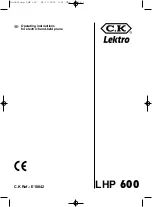
-39-
2. Jitter Check
1) While oscilloscope is kept connected in the same test point as in
step1. RF WAVEFORM CHECK, connect the output terminal of
an oscilloscope to the input terminal of the jitter meter.
2) Set the VOLT range selector of oscilloscope to 500mV range or below.
3) Play back secnod track of TCD-782.
4) Check that jitter meter indicates 28.0ns or less.
3. Traking Balance Check
1) Connect the TE and Vref to the oscilloscope.
2) Playback the second track of TCD-782 and press the PAUSE butten.
3) Check that the ttaverse waveforms of oscilloscope are up and down symmetrical.
4. Play Ability Check
1) Play back the 3rd , 8th and 13th track of ATD-001. Check that the noise does not occur sound skipping does not occur.
OUT PUT
ns
INPU T
TP- R F
TP- Vref
JITTER METER
OSCILLOSCOPE
OUTPUT
TP- TE
TP- Vref
OSCILLOSCOPE
ELECTRICAL ADJUSTMENT -5/5
CD CHECK
Perform the adjustments after the main unit enters the test mode.
Place the CD mechanism on level ground.
Equipment and tools required
Measuring equipment
• Digital multi-meter
• Oscilloscope ( 10:1)
• Jitter meter (KIKUSUI 6235)
Test disc: TCD-782
ATD-001
1. Rf Waveform Check
1) Connect oscilloscope to the test point RF and Vref.
2) Play back the second track of TCD-782.
3) Check that the RF waveform has the maximum amplitude and the center
of the wedge waveform has the clear blank.
OSCILLOSCOPE
OUTPUT
TP-RF
TP-Vref
Vref
RF
FE
TE
I
C402
I
C401
CD PWB
4pin
3
1 2 3
1 2
















































